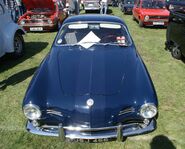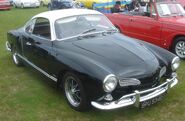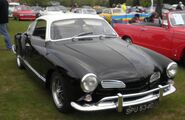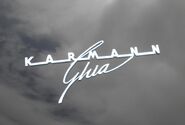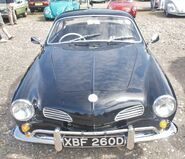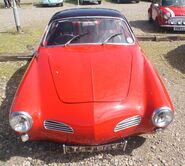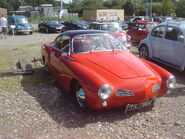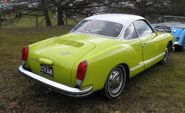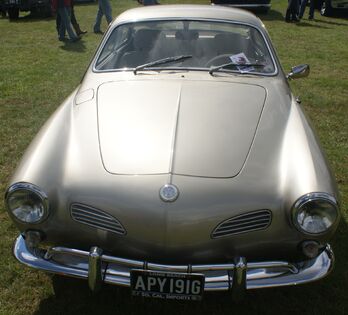
Volkswagen Karmann
The Karmann Ghia is a Volkswagen powered, coach-built automobile. The first Ghia was introduced in 1956. It used the chassis, suspension and drive train from the Type 1 Beetle.
The Karmann Ghia and Bug are mechanically and electrically identical from 1956 through 1974; their chassis are not interchangeable. The car was available as a coupe and cabriolet convertible. The Karmann Ghia is the only Volkswagen powered, coach-built automobile that carries the Volkswagen logo, and was officially sanctioned by Volkswagen AG. The Volkswagen Karmann-Ghia was a German-Italian joint effort introduced in 1955. Dr. Wilhelm Karmann, whose firm was building the cabriolet version of the Beetle, submitted designs to Volkswagen in hopes of generating new business. The designs were for a new sporty coupe, which Volkswagen ignored.
Around the same time, Mario Boano and Luigi Segre of Italy's Carrozzeria Ghia had proposed some styling enhancments to Volkswagen. These too were ignored. Karmann approached Ghia directly, resulting in a prototype. Using a Beetle, Ghia developed a new body that was mounted directly to the Beetle's basic platform chassis. The prototype was sent to Karmann in late 1953 and used to impress Volkswagen's chief Heinz Nordhoff. There were slight differences to the Beetle's body; the new coupe had slightly wider bodywork and a lower roofline. There was a bulge in the rear fenders and an extended lower-body crease. Some of these design features were shown on the Chrysler-Ghia d'Elegance Concept car of 1953.
In 1955, the Karmann-Ghia was a very popular vehicle and would remain in production until July of 1974 after 283,501 coupes and 80,897 convertibles had been produced. This Karmann-Ghia is a late-production convertible that has been treated to a professional mechanical and cosmetic restoration. It is painted in red, has a white interior, and woodgrain dash and black convertible top. There are United States specification bumpers complete with override bars and the original-type ventilated steel wheels with bright hubcaps and whitewall tires. In 2009, this Convertible was offered for sale at the Automobiles of Amelia Island Auction presented by RM Auctions. It was estimated to sell for $15,000-$20,000 and offered without reserve. As bidding came to a close, the lot had been sold for $13,200, including buyer's premium.In 1950, Karmann approached Volkswagen with a design for a new vehicle. Karmann had a working relationship with Volkswagen that went prior to this project that included the Volkswagen Beetle Cabriolet.
The idea was initially rejected by Volkswagen so Karmann approached the coachbuilding company Carrozzeria Ghia of Turin who built the first prototype of the vehicle, completing in 1953. In November of 1953, Nordhoff, the head of Volkswagen at the time, gave approval for the vehicle to be built by his company. On July 14th in 1955, the vehicle was unveiled to the public. There were basically three types of the Karmann-Ghia's built during its life span that included the type 14, type 34, and the TC. The type 14 featured a round body-style that received very little modifications through its production life-span, dating from 1955 through 1974. Most of the modifications that did transpire were head and tail light modifications, bumper and side air vent changes. During which time about 340,000 coupes and 81,000 convertibles were produced in Osnabruck Germany. Manufacturing continued from 1962 through 1972 in Sao Bernardo do Campo in Brazil where 176 convertibles and about 23,000 coupes were produced. These type 14 models were basically unaltered for the original design except for different bumpers, taillights and vent windows.
The Type 34, or 'Razor Edge', was produced from 1961 through 1969 during which time 43,000 examples were produced. It was introduced in September of 1961 at the Frankfurt Auto show. The Type 34 were 'boxier' than their Type 14 counterparts and cost more to produce. The interior was larger and better equipped, the structure was stronger, and the engine was faster. They were built in coupe design only, however in 1962 a sunroof could be had. The engine was initially 1500cc in size but later increased to 1600cc.
The 1600 TC, which stood for Touring Coupe, was produced in Brazil from 1970 through 1975. They were based on the design of the type 34. During its lifespan, 18,000 examples were produced.A red sports car barrels through a deserted landscape, driven by a helmet-clad professional as an excited announcer extols the virtues of the commercial's featured automobile. Surely Volkswagen did not invent this archetypal format of romanticized car ad when they borrowed it to market their Karmann Ghia to bored TV audiences. Volkswagen's seemingly ordinary commercial included a twist ending, though. As the camera follows the sleek sports car deeper into the surrounding scenery, a paper wall emerges in the corner of the screen. Okay, okay—so this isn't really all that new of an idea either, right? The car will smash through the paper barrier and appear on the other side, some tired metaphor for the birth of a supposedly new automotive idea, looking even more glamorous and wonderful than ever. But that's not how Volkswagen ended their commercial. Instead, their Karmann Ghia plows into the wall, not through it. The thin paper barrier stops the little car that couldn't dead in its tracks, as the driver repeatedly engages reverse and first gears in an attempt to smash through the wall. The announcer explains this phenomenon through his confident declaration that, 'The Volkswagen Karmann Ghia is the most economical sports car you can buy… it's just not the most powerful.'
Self-deprecating humor is not a traditional ingredient in the typically brash and boastful world of automobile advertising. Volkswagen, though, was far from a traditional company when it introduced its Karmann Ghia to adoring audiences, and its cleverly charming and endearingly modest ad campaign accurately represented the character and intent of their little, underpowered sports car.
Based on the ruggedly simple but far from sporty underpinnings of their Beetle, Volkswagen's Karmann Ghia debuted with an underwhelming 36 horsepower and a swing-axle rear suspension prone to induce snap oversteer in frisky corners. This, perhaps, was not the recipe for a true sports car. The Karmann Ghia had looks, though, and what the little German lacked in power and performance it made up for with an affable demeanor and delightfully low running costs. So while this spruced-up Bug might not have appealed to the more hardcore buyers of MGs, Triumphs, Alfas, and Morgans, the VW found itself plenty of friends and earned itself an impressive twenty-year production run. The name of the Volkswagen Karmann Ghia seems to give away much of the car's history. It was, of course, a Volkswagen and used standard Volkswagen mechanical bits. Karmann, a renowned German coachbuilder, fabricated its carefully constructed bodywork. Ghia, a prestigious Italian design house, penned its elegant shape. The story behind the car's development, though, was actually far more complicated than the easily-decoded nomenclature suggests. More specifically, the design of the Karmann Ghia remained for many years something of a mystery. Simply attributing the styling to Ghia would be inaccurate and unfair to the individuals responsible for the car's timeless contours.
Several years before the Karmann Ghia's debut for 1955, Volkswagen had requested that Karmann design a sports car to be built over a Beetle chassis. Karmann developed several proposals, but all of these were rejected by Volkswagen. Luckily, Karmann head Wilhelm Karmann was friends with Ghia chief engineer and designer Luigi Segre. Karmann brought the Volkswagen project to the attention of Segre, who later surprised Karmann with a completed prototype styled and produced at Ghia in 1953. Karmann introduced Segre's project to highly impressed Volkswagen officials, and from that point on Ghia's initial design was further developed into the Volkswagen Karmann Ghia. The designer of the lovely bodywork that emerged from Ghia's shops, though, was never officially identified. Virgil Exner claimed that the design for the Karmann Ghia was based upon his Coupe D'Elegance, a car he designed for Ghia, while the Ghia company itself stated that their own Mario Boano created the design in 1950. Likely, the final design was influenced by both Exner and Boano, especially given the latter's work on stylistic predecessors to the Karmann Ghia such as the Alfa Romeo 2500 S convertible of 1949 and a Lancia Aurelia limousine of 1950 (automotive historian Jan Norbye identified the stylistic similarities between these models).
Despite the uncertainty surrounding the Karmann Ghia's design, its shape proved immediately successful and enduringly beautiful. The earlier models, produced from 1955 to 1959 and now often called 'lowlights,' were the purest with their tiny taillights, smaller front grilles, and lower headlight mounting positions unaffected by later headlight height regulations. All subsequent Karmann Ghias maintained much of the original design's character and grace, though, as the car never faced a full redesign.
Volkswagen enlarged the car's taillights, raised the headlight mounting places, and widened the front grilles (used only for cabin ventilation as the engine was air-cooled and rear-mounted) for 1960, but even these changes kept intact the car's delightfully mouse-like face and superb proportions. Later models looked bulkier, with taillights that kept growing, bigger front turn indicators, and bulkier bumpers, but even the final models retained sheetmetal nearly as pretty as that of the very first models. Luckily, the discontinuation of the model after 1974 prevented the design from being marred by the infamous federal bumper regulations imposed in 1975. Though Karmann Ghia bumpers were enlarged in 1972, they remained far more attractive and better-integrated than the rubber units forced upon so many hapless little sports from 1975.
Every bit as impressive as the Karmann Ghia's styling was its build quality. Karmann did a wonderful job crafting the car's timeless forms, hand finishing the bodies for an attention to detail unprecedented in such an affordable car. Despite the cars' eventual propensity to develop rust problems, Karmann treated the Volkswagens with careful corrosion protection and sophisticated painting techniques. The flowing compound curves that defined the Karmann Ghia's excellent styling were shaped by Karmann with unerring finesse, and finished to a remarkably high standard.
Initially offered only as a coupe, Volkswagen introduced a Karmann Ghia cabriolet for 1957 that continued in production alongside the coupe until the 1974 model year, after which the Scirocco hatchback replaced the Karmann Ghia model range. The cabriolet retained all of the coupe's great looks. Surprisingly, it also retained much of the coupe's all-season drivability, thanks to Karmann's advanced convertible top with its effective insulation and glass rear window. Never offered with more engine than a 60-horsepower, air-cooled flat four, the Karmann Ghia simply could not accelerate like a proper sports car—and with its substantial rear weight bias, handling was never ideal. For 1967, disc brakes and a revised rear suspension endowed the Karmann Ghia with greater performance potential, but it remained the German tortoise amongst British and Italian hares. As the advertisements declared, though, Volkswagen never pretended that the Karmann Ghia intended to compete directly with real sports cars. Instead of raw excitement, the Karmann Ghia offered peace of mind: reliability instead of maintenance hassles; easily attainable parts and good service instead of spotty dealer networks; everyday usability instead of occasional fun. But despite these relatively staid traits, the Karmann Ghia also offered buyers something truly exciting—it provided its owners the chance to experience a car of exceptional style and undisputed quality. With roughly 360,000 coupes and 80,000 cabriolets produced, the Karmann Ghia brought the joys of owning a rare car to buyers who knew they really needed a common one.
Type 34 Karmann Ghia

1965 VW Karmann Ghia Type 34 hatchback prototype
In September 1961, Volkswagen introduced the VW 1500 Karmann Ghia, or Type 34, based on its new Type 3 platform, featuring Volkswagen's new flat 1500cc engine design, and styling by Italian engineer Sergio Sartorelli. Due to model confusion with the Type 14 1500 introduced in 1967, the Type 34 was known variously as the "Der Große Karmann" ("the big Karmann") in Germany, "Razor Edge Ghia" in the United Kingdom, or "European Ghia" (or "Type 3 Ghia" among enthusiasts) in the United States. Today the name Type 34 is recognized as the worldwide naming convention.
The second automobile model in the world to have this option, an electrically operated sliding steel sunroof was optional in 1962. The styling offered more interior and cargo room than the original Karmann Ghia. It featured an electric clock, three luggage spaces, built-in fog lights, round tail lights, upper & lower dash pads, door pads, & long padded armrests. It was the fastest production VW model of its day.
Until it was replaced by the VW-Porsche 914, it was the most expensive and luxurious passenger car VW manufactured in the 1960s — back then you could have purchased two basic Beetles for the price of one Type 34 in many markets. The comparatively high price meant it never generated high demand, and only 42,505 (plus 17 prototype convertibles) were built over the car's entire production life between 1962 and 1969 (roughly 5,000 a year). Today, the Type 34 is considered a semi-rare collectible with values ranging from US$25K (nice original or restored) to $8K (driving project) to $3K (non-driving parts car). Values in Europe are the highest with an unrestored original Pearl White 1962 Coupe selling for US$34,000 in Germany in late 2010.
Although the Type 34 was available in most countries, it was not offered officially in the U.S. — VW's largest and most important export market — another reason for its low sales numbers. Many still made their way to the USA (most via Canada), and the USA has the largest number of known Type 34s left in the world (400 of the total 1,500 to 2,000 or so remaining).
Like its Type 14 brother, the Type 34 was styled by the Italian design studio Ghia. There are some similar styling influences, but the Type 14 Ghia looks very different from the Type 34. The chassis is also a major difference between the cars: the Type 14 shares its chassis with a Beetle, whereas the Type 34 body is mounted on the Type 3 chassis and drive train (the same as in a 1500/1600 Notchback, Variant (Squareback) and Fastback) — all distinguished by the standard 1500 pancake engine that allowed a front and rear boot. The Type 34 is mechanically the same as other Type 3s. All bodywork, interior, glass, bumpers, and most of the lenses are unique to the Type 34.
The Wilhelm Karmann factory assembly line which assembled the Type 34 also produced the VW-Porsche 914 (known as Porsche 914 in the USA) — the Type 34's replacement.
Karmann Ghia TC
As an alternative to the Type 34 Karmann-Ghia coupé, which Volkswagen had introduced to Europe in 1961, Karmann-Ghia do Brasil looked to Ghia in Turin for a reworked version of the Type 14 at the end of the 1960s. At the time Ghia employed Giorgetto Giugiaro, the famous Italian designer and he was set to work on the new Brazilian Karmann Ghia. The result was the Volkswagen Karmann Ghia TC (Touring Coupé), internally known as the Type 145, which was introduced in 1970.
This model looked much like an Italian impression of a Porsche 911 and was a roomy 2+2 coupe with a modern and comfortable interior. Underneath it was similar to the Type 14 though actually the platform of the Volkswagen Variant was used rather than that of the Volkswagen Beetle. The main difference was the engine: the Type 145 TC was fitted with the 1584 cc flat-four air-cooled boxer unit from the Type 3 instead of the 1192 cc unit of the Type 14. The car had 65 hp (48 kW) @ 4600 rpm and a top speed of 86 mph (138 km/h), compared to the 34 hp (25 kW) and 72 mph (116 km/h) of the Type 14.
18,119 TC models were produced during its production run from 1970 until 1976. It was only offered in South America and wasn't exported off the continent. There is a prototype that is part of the factory museum collection of Karmann in Osnabrück, Germany.







